A homemade foam boat. How to make a boat out of foam
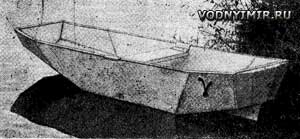 The foam boat «Gamma» is afloat. |
Let me remind you of the main advantages of styrofoam over «traditional» materials usually used for the construction of such boats (we will not talk about thermoplastics, which are not yet available). The foam is light, has sufficient strength, high thermal insulation qualities, cuts and saws well (foams such as PS-1 and PSBS are perfectly cut with a nichrome string heated when an electric current is connected to it), adheres well. On the other hand, it is impossible to bend the foam.
To test the capabilities of the PS-1 foam, I made a setless unsinkable rowing boat «Gamma» out of it, which, with a weight of about 20 kg, has a load capacity of 120 kg and is quite convenient to operate, especially when going fishing in a passenger car.
| The main dimensions of the foam boat | |
|---|---|
| Longest length, m | 2,60 |
| Gunwale width, m | 1,05 |
| Bottom width, m | 0,78 |
| Side height amidships, m | 0,38 |
| Side height at the extremities, m | 0,40 |
When designing, the most difficult thing was to choose the shape of the hull: it was necessary to make a seaworthy, easy-to-manufacture and convenient vessel out of flat elements.
In the end, it turned out to be a foam boat with a transom nose and stern, a keeled bow, inclined (with a collapse) sides and a flat bottom, slightly raised to the stern (a stern fin is installed here).
Theoretical drawing of a foam boat hull
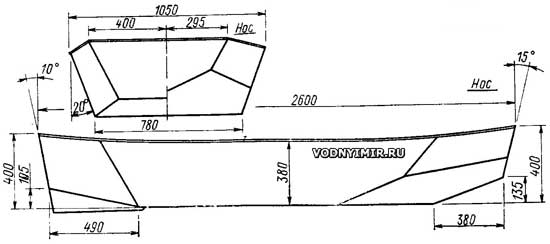
Individual flat parts with a thickness of 30 mm after gluing form a monolithic structure. The transoms are made of a sheet twice as thick and smoothly beveled along the contour. The joining edges of the connected parts are cut off at an angle, as shown in boat sketch. This gives an increase in the area of bonding along the joints and somewhat simplifies the cutting of sheets, since there is no need to recalculate the dimensions by the thickness of the sticking part.
The construction of a foam boat can be divided into three stages: cutting of sheets — production of hull parts; fitting of parts at the joints — assembly; gluing and final finishing.
Cutting foam boat parts
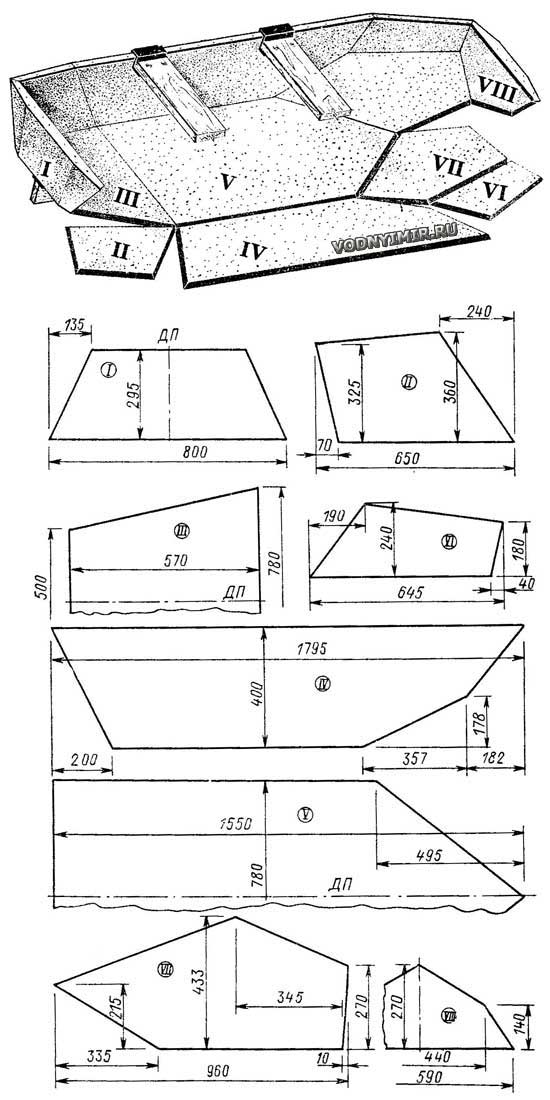
zoom in, 1248x2642, 326 KB
I — aft transom; II — aft part of the side (2 pcs.); III — aft part of the bottom; IV — side (2 pcs.); V — bottom; VI — bow of the side (2 pcs.); VII — zygomatic sheet (2 pcs.); VIII — the bow transom.
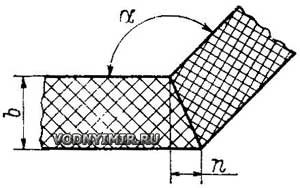 Diagram of the angular connection of parts. |
For more efficient use of the material when cutting sheets, I recommend cutting patterns-templates out of thick paper beforehand. After cutting out all the details along the connected edges, it is necessary to cut the angle — remove the chamfer by the amount of n (see the sketch above), which, depending on the central angle a and the thickness of the sheet 6 is defined by the formula:

If you do not have confidence in the straightness of the edges, only one of them should be cut «at an angle»; the edge sticking to it will have to be adjusted during assembly.
For the convenience of fitting and assembly, it is best to make a slipway of five pairs of «transverse» and two pairs of «longitudinal» keel blocks that fix the position of the parts of the bottom and sides, as well as the bow and stern transoms.
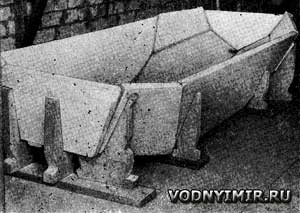 Glued hull on the slipway. |
Gluing can be done with any glue recommended for foam. I used epoxy glue based on ED-5 resin. After the glue had fully risen, he touched the free edge of the side and put a wooden collar on it around the perimeter of the hull — an oak bar on glue and screws. For reliability, at all corners and butt joints at the level of the upper edge of the side, I applied longitudinal strips made of AMg alloy from the outside (strip 1.5x20 with a length of 130 mm on the side from the axis of the joint). The same strip bound the aft fin, placed on the bottom.
After putty and stripping, the case was coated with nitroemal from the outside and inside. Such protection turned out to be almost enough, so it is quite possible to do without pasting the foam with fiberglass, etc.
Removable cans, which serve simultaneously as cross-links, bursting the sides, are made of wood on the «Gamma». They will turn out easier if they are cut out of styrofoam, letting the reinforcing wooden slats along the edges. The cans are hung on the sides with the help of gripper clips bent from scraps of AMg alloy. The steering wheel is mounted on pins placed on the aft transom.
Having already started testing the «Gamma», I still doubted the correctness of the choice of material, fearing for the strength of the foam body. However, with each new exit, I felt more and more confidence in my boat. Sailing in a variety of conditions, transportation and dragging, when it is difficult to exclude all kinds of impacts, sometimes very strong, have shown that the boat is strong (even when it is not loosened by banks) and reliable. And there is nothing to say about unsinkability: it is almost impossible to drown the «Gamma». The foam boat has other specific advantages. The complete absence of a set and any slates helps to keep the inside of the boat clean. Thanks to the good thermal insulation qualities of the foam in the boat, you can sit right on the bottom; when it is pulled ashore, I settle down in it for the night, without risking catching a cold from the ground.
Recommending styrofoam for the manufacture of light shuttle-aces, I want to mention one of its disadvantages: it is afraid of fire! In other words, it should be remembered that the proximity of a campfire can ruin your boat; even the touch of a lit cigarette melts the foam.
Boat projects for self-construction
Share this page in the social. networks or bookmark:
